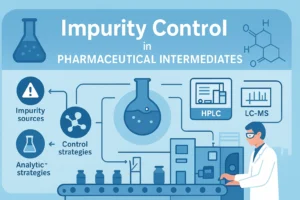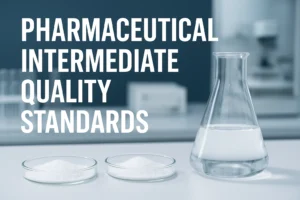In the complex chain of chemical drug development, pharmaceutical intermediates serve as the core link between base raw materials and final drug products. Their quality directly determines the purity, stability, and clinical efficacy of the API.
A truly knowledgeable client will repeatedly confirm your impurity control strategy and inquire about change management records, because quality control details are the key factor that determines everything.
Today, we will analyze five key points in pharmaceutical intermediate quality control, which are the real thresholds that determine the success or failure of a partnership.
The First Key Point: Starting Material Control—A Small Error Can Lead to a Thousand Miles of Error
In the precise chain of pharmaceutical manufacturing, the quality control of active pharmaceutical ingredient starting materials (API-SMs), as the starting point of drug synthesis, directly determines the safety, efficacy, and stability of the final drug.
An FDA survey shows that 25% of global drug recalls are due to starting material quality issues, while statistics from the European Medicines Agency (EMA) indicate that process deviations caused by starting material defects account for 40% of all GMP defects. We now take starting material control to the utmost:
Establishing “black box” documentation on suppliers: This not only audits production processes but also examines their equipment materials and cleaning procedures.
Enhanced incoming inspections: In addition to standard indicators, we now test for 24 metal residues using ICP-MS and verify optical purity using chiral HPLC.
Implementing a first-drum confirmation system: The first drum of each batch is sampled and fully inspected, and only unloaded after passing the inspection is permitted.
The Second Key Point: Process Control
Intermediate synthesis is not like cooking; you can’t just dismiss it as finished. For example, in the crystallization process of an antiviral intermediate, the same formula produced completely different crystal forms in summer and winter, resulting in significant differences in the dissolution of the downstream API. It was later discovered that the cooling curve was incorrectly configured, with the cooling water temperature fluctuating by only 3°C depending on the season.
Key process parameters must be strictly adhered to:
- Establishing a process design space: Determine the allowable range of each parameter through DoE experiments. For example:
- Reaction temperature: ±2°C (exceeding this limit triggers a deviation investigation)
- Addition time: ±5 minutes (equipped with a high-precision metering pump)
- pH range: ±0.3 (online pH meter for real-time monitoring)
- Implementing process analytical technology: Near-infrared monitoring of the reaction endpoint to prevent over-reaction and the generation of new impurities
- Critical operation video traceability: High-risk steps (such as low-temperature reactions and the addition of highly toxic materials) are fully recorded and archived.
The Third Key Point: Impurity Profile Research—Seeing those “Invisible” Risks
Impurity research is the most challenging aspect of technical expertise. FDA data shows that 45% of global drug registration failures are directly due to inadequate impurity control, while EMA statistics indicate that impurity-related defects account for 62% of GMP inspection defects.
This field is a test of technical prowess due to its complexity, spanning multiple disciplines such as chemical analysis, toxicological assessment, and process optimization, and the challenges of addressing the entire supply chain from laboratory to industrialization. A complete impurity profile study must include:
- Known known impurities: process byproducts and degradation products, with development of dedicated detection methods
- Known unknown impurities: all impurities generated by forced degradation, with structural identification
- Unknown unknown impurities: screening using LC-MS multidimensional technology and establishing an impurity profile
- Genotoxicity assessment: all impurities are classified according to ICH M7, and QSAR predictions are performed when necessary
Table: Impurity Control Strategy for a Cardiovascular Intermediate
Impurity name | Source | Acceptability Criteria | Control Measures |
Isomer A | Synthesis by-products | ≤0.10% | Optimizing crystallization procedures |
Dechlorination | product Carryover from starting material | ≤0.15% | Strengthen supplier control |
Dimer | Storage degradation | ≤0.05% | Nitrogen blanketing, low-temperature storage |
The Fourth Key Point: Data Integrity—Every Chromatogram Must Withstand Scrutiny
In the quality control system of pharmaceutical R&D and production, the requirement that “every chromatogram must withstand scrutiny” is not just a requirement; it is the core embodiment of data integrity.
An FDA survey shows that 65% of global drug registration warning letters are directly related to data integrity deficiencies, 42% of which involve falsification or manipulation of atlas data.
This requirement is driven by the triple imperatives of scientific rigor, regulatory compliance, and risk control. As the saying goes, data integrity is the foundation of quality control; without a solid foundation, nothing else matters.
We now implement the most stringent data management:
- Triple backup of raw data: real-time synchronization between instrument computers, servers, and off-site cloud storage
- Full audit trail coverage: Any data modification automatically records the time, person, and reason
- Standardized electronic signatures: Double review of each inspection step is a mandatory system requirement
- Regular data health checks: 10% of data is spot-checked quarterly to ensure integrity and reliability
The Fifth Key Point: Change Control—Every Change is a Risk
A classic industry case: A company changed the seal material of a transfer pump. Extractables resulted in the detection of new impurities in the entire batch of intermediates. This lesson teaches us:
Changes must adhere to the following ironclad principles:
- Perform thorough pre-change assessments: From minor changes like changing filter brands to major changes like changing reactor materials, a risk assessment must be conducted.
- Rigorous validation during changes: Verify process robustness and quality consistency for at least three consecutive batches.
- Continuous post-change monitoring: Extend the observation period for samples from the first commercial production run to the expiration date.
Conclusion: Quality Control is not a Cost, but an Investment
True quality control isn’t a SOP posted on the wall; it’s a conscious effort ingrained in every employee. Tianming Pharmaceutical Group has 15 years of experience in pharmaceutical intermediate R&D and production. Our product line encompasses a wide range of intermediates in the anti-tumor, anti-diabetic, anti-infective, and Orforglipron series, encompassing over 100 products. Click here to experience our partnership standards:
Email: sunqian0123@gmail.com
WhatsApp: +86 176 6371 3557



